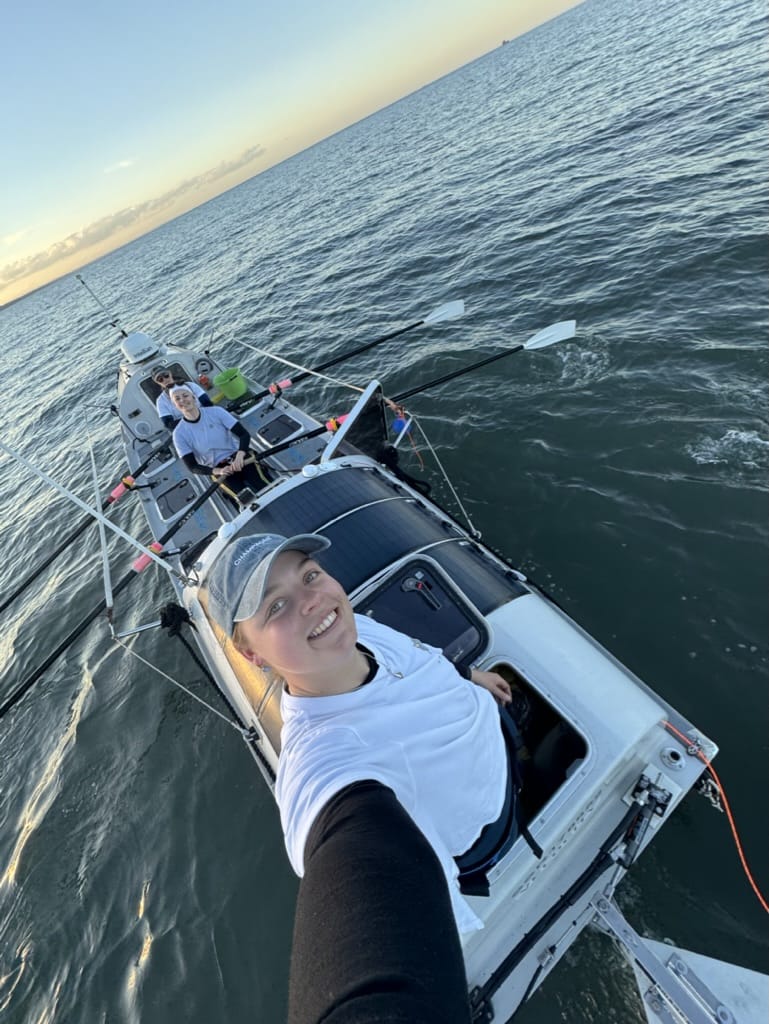
Seas the Day seeks sponsors for unsupported row across Pacific from Peru to Australia

An all female trio is aiming to become the first team to row nonstop and unsupported across the Pacific Ocean, from Peru to Australia. The 8,000 mile expedition, taking place in 2025, could take up to six months and it’s aiming to break three world records in the process, namely: the youngest team to row the full Pacific Ocean, the first team to row the full Pacific Ocean nonstop and unsupported, and the first trio to row the full Pacific Ocean.
Jess Rowe (pictured above on right), who works for DG Maritime as a navigation account manager, is part of the team. She says the idea came about when she and Miriam Payne (pictured centre) had completed the World’s Toughest Row, 3,000 miles (2022). They were each considering their next challenge and decided the organised races on offer weren’t enough.
“Instead, we began planning an independent crossing [of the Pacific] and formed a team of three, including Lottie Hopkinson-Woolley (pictured left), who is new to rowing but has a background as a sailing instructor. Our plans evolved into something quite ambitious while we were sitting on the edge of a hotel bed in English Harbour, Antigua, just days after completing our first ocean row.”
Currently the team’s spending hours in the gym each week, weekends in the yard working on the boat Velocity (which boatbuilder Rory Pulman was instrumental in refitting), and extensive time training on the water, practising shift patterns and getting familiar with the boat.
Now Rowe’s looking for additional support. “Many of you who read MIN may be able to help with supplies we still need,” she says, “which include essential safety equipment, electrical communication equipment and corporate sponsorship to cover the rest of our costs. Items including lifejackets, halyard bags for storage and flares in case of emergency still need to be purchased. Rowing across the Pacific Ocean will be a massive challenge, even before we reach the start line.”

And those that do help? Not only will that be supporting the team, they’ll potentially have the opportunity of appearing in a documentary that’s being made about the team.
It’s being made by Chrome Productions, although most of the filming will be done by the rowers.
“It’s crucial to remember to capture our activities each week,” says Rowe. “This includes recording updates on how the week is going, meetings with sponsors, or measuring the cabin space for mattresses. We constantly keep in mind the need to gather as much footage as possible.
“We’ve also participated in interviews with the team at Chrome, who have visited our homes to film training sessions, meal testing, and the occasional cold plunge, which is highly beneficial for muscle recovery. Although it took some time to get used to being filmed, they remain unobtrusive, quietly capturing the best moments, for which we are extremely grateful.”
Rowe likes taking on big challenges. It runs in the family (her father, Nick Rowe, rowed across the Atlantic in a pair back in 2005). So she skippered a team across the Atlantic Ocean in 2022 as part of the World’s Toughest Row. That had its challenges, she says, but not enough to put her off.
Issues with autohelm on World’s Toughest Row
“We faced issues with our autohelm, struggling to stay on course when the wind and swell turned us around at the trough of a wave, triggering the alarms. We had three autohelms, which we alternated as they overheated in the cabin, where it was nearly 40 degrees Celsius. They drained our power, so we had to be careful not to deplete the batteries. Some nights, we hand-steered using our compass, following Orion’s Belt as it appeared above the stern cabin and moved across the night sky.
“Nobody sustained any significant injuries and our extensive training had built up callouses on our hands, preventing blisters. However, our bottoms were in rough shape. Rowing for two hours on and off in the heat typically leads to salt sores, which are unavoidable for ocean rowers. You can manage them with a strict hygiene routine between shifts. Products like alcohol, Sudocrem, and E45 become essential.”
Even with that pain, she can’t help but continue to chase the freedom of rowing, of being so far from civilisation that she’s closer to the space station than to land.
“The brutal yet simple life of just rowing, eating, and sleeping; surfing massive waves; being so close to whales and other marine life that you could almost touch them, is addictive,” she says. It provides an adrenaline rush during storms and builds mental resilience by being in difficult and dangerous situations.
“Rowing across the Pacific will be nearly three times as long and take significantly more time than rowing across the Atlantic. While the physical demands of the rowing pattern will be intense, I’m not particularly concerned about the mental preparation. If I weren’t committed to the challenge, it might be a mental struggle, but that’s definitely not the case.”

Rowe admits that post-adventure blues are real. She says it’s crucial to have something planned for her return. “When I saw land on the final day of my Atlantic crossing, it hit me that the challenge was almost over. All the preparation and years leading up to crossing the finish line would soon be over. The challenge was ending and I never wanted it to.”
Earlier in 2024, a transatlantic rower was found dead on his boat while attempting a charity challenge. The British man fell ill while attempting to row across the Atlantic to raise money for charity. Around 700 miles into his challenge he told his support team he was feeling unwell, suspecting a reaction to antibiotics.
The post Seas the Day seeks sponsors for unsupported row across Pacific from Peru to Australia appeared first on Marine Industry News.
